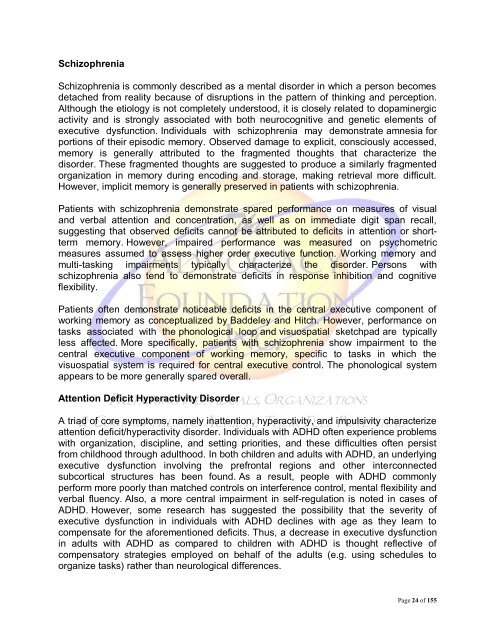Organizational Dysfunction
Organizational Dysfunction
Organizational Dysfunction
You also want an ePaper? Increase the reach of your titles
YUMPU automatically turns print PDFs into web optimized ePapers that Google loves.
Schizophrenia<br />
Schizophrenia is commonly described as a mental disorder in which a person becomes<br />
detached from reality because of disruptions in the pattern of thinking and perception.<br />
Although the etiology is not completely understood, it is closely related to dopaminergic<br />
activity and is strongly associated with both neurocognitive and genetic elements of<br />
executive dysfunction. Individuals with schizophrenia may demonstrate amnesia for<br />
portions of their episodic memory. Observed damage to explicit, consciously accessed,<br />
memory is generally attributed to the fragmented thoughts that characterize the<br />
disorder. These fragmented thoughts are suggested to produce a similarly fragmented<br />
organization in memory during encoding and storage, making retrieval more difficult.<br />
However, implicit memory is generally preserved in patients with schizophrenia.<br />
Patients with schizophrenia demonstrate spared performance on measures of visual<br />
and verbal attention and concentration, as well as on immediate digit span recall,<br />
suggesting that observed deficits cannot be attributed to deficits in attention or shortterm<br />
memory. However, impaired performance was measured on psychometric<br />
measures assumed to assess higher order executive function. Working memory and<br />
multi-tasking impairments typically characterize the disorder. Persons with<br />
schizophrenia also tend to demonstrate deficits in response inhibition and cognitive<br />
flexibility.<br />
Patients often demonstrate noticeable deficits in the central executive component of<br />
working memory as conceptualized by Baddeley and Hitch. However, performance on<br />
tasks associated with the phonological loop and visuospatial sketchpad are typically<br />
less affected. More specifically, patients with schizophrenia show impairment to the<br />
central executive component of working memory, specific to tasks in which the<br />
visuospatial system is required for central executive control. The phonological system<br />
appears to be more generally spared overall.<br />
Attention Deficit Hyperactivity Disorder<br />
A triad of core symptoms, namely inattention, hyperactivity, and impulsivity characterize<br />
attention deficit/hyperactivity disorder. Individuals with ADHD often experience problems<br />
with organization, discipline, and setting priorities, and these difficulties often persist<br />
from childhood through adulthood. In both children and adults with ADHD, an underlying<br />
executive dysfunction involving the prefrontal regions and other interconnected<br />
subcortical structures has been found. As a result, people with ADHD commonly<br />
perform more poorly than matched controls on interference control, mental flexibility and<br />
verbal fluency. Also, a more central impairment in self-regulation is noted in cases of<br />
ADHD. However, some research has suggested the possibility that the severity of<br />
executive dysfunction in individuals with ADHD declines with age as they learn to<br />
compensate for the aforementioned deficits. Thus, a decrease in executive dysfunction<br />
in adults with ADHD as compared to children with ADHD is thought reflective of<br />
compensatory strategies employed on behalf of the adults (e.g. using schedules to<br />
organize tasks) rather than neurological differences.<br />
Page 24 of 155

















